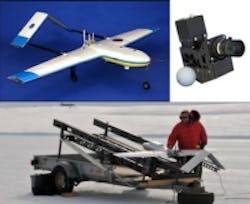UAVs to utilize hyperspectral sensors for ocean research
Researchers from Columbia University’s Air-Sea-Ice Physics and Biogeochemistry Experiment (ASIPBEX) will utilize unmanned aerial vehicles (UAV) to investigate climatological changes present in the Arctic Ocean around Svalbard, Norway.
MORE ARTICLES
Leica Geosystems and Headwall Photonics enter UAV imaging agreement
Will the machine vision market grow in 2015?
Vision Systems Design announces 2015 Innovators Awards program
In the remote sensing project, the UAV will assess ocean and sea ice variability in this Arctic zone. The UAV will be fitted with two Micro-Hyperspec hyperspectral sensors from Headwall Photonics, the first of which— the A-Series sensor—covers the visible near infrared (VNIR) spectrum (400-1000 nm). This sensor is fitted with a silicon CCD focal plane array with a 7.4 µm x 7.4 µm pixel size. It features a 1.9 nm spectral resolution, a dynamic range of 60 dB, and a frame rate of greater than 90 fps. In addition, it has an ADC bit depth of 12 and has a base CameraLink interface
Headwall’s Micro-Hyperspec T-Series sensor, the UAV’s second sensor, covers the near-infrared (NIR) spectrum (900-1700 nm). This TE-cooled sensor features an InGaAs infrared focal plane array with a 25 µm x 25 µm pixel size, as well as a 5 or 10 (dispersion dependent) spectral resolution, a dynamic range of 76 dB, and a frame rate of greater than 100 fps. It also features an ADC bit depth of 14 and has a base CameraLink digital output format.
Together, the two sensors, along with Headwall’s Hyperspec II airborne software, will be used to detect indicators of sea ice physics, solar warming, and global carbon cycles.
"The UAS allows scientists to measure in places that typically are impossible to get to using ships or manned aircraft," stated Christopher Zappa, a Lamont Research Professor at Columbia's Lamont-Doherty Earth Observatory in a Headwall press release. "This opens up the possibility for transformative understanding of the climate system. Since we're using a UAS, we depend on 'seeing' as much of the ocean surface as possible, minimizing any aberrations or unwanted artifacts along the edges of the field of view."
ASIPBEX is part of an international collaborative investigation of climate cryosphere interaction with colleagues from Spain, Germany and Norway.
View more information on Micro-Hyperspec sensors.
Share your vision-related news by contacting James Carroll, Senior Web Editor, Vision Systems Design
To receive news like this in your inbox, click here.
Join our LinkedIn group | Like us on Facebook | Follow us on Twitter | Check us out on Google +
About the Author

James Carroll
Former VSD Editor James Carroll joined the team 2013. Carroll covered machine vision and imaging from numerous angles, including application stories, industry news, market updates, and new products. In addition to writing and editing articles, Carroll managed the Innovators Awards program and webcasts.
